I’m taking it easy this weekend after a somewhat exhausting period of webhost migration hell (my bandwidth increased enough to necessitate moving to a more expensive plan) and with liquidweb, that meant some tricky maneuvers on my end of things. So, Forgotten NY correspondent Gary Fonville, a former NYC bus driver, has come up with some scenes around town of decaying and decrepit subway and train scenes at a time when new shiny things like a new exit to downtown Brooklyn’s hunk of rust-look, Barclays Center, as well as a much-delayed transfer between the IND B/D/F trains and the IRT #6 at Bleecker Street have opened. (To me, this kind of subway miscegenation will be the downfall of us all).


Trains have been running near this abandoned LIRR substation since about 1840 or so. However, the LIRR was electrified on this section of their system in 1905 and this edifice. Is there any FNY fan who knows when the substation was decommissioned? Location: Van Sinderen Avenue & Atlantic Avenue, East New York, Brooklyn.
This former substation is very conspicious, but the name “Long Island Railroad” isn’t!

Since this edifice is located at Central Park West & 104th Street, it leads me to believe this may be an emergency entrance/exit for the long, deeply bored tunnel between 96th Street & 110 Street on the #2&3 lines. The distance between those two stations is the longest gap between stations on the #2&3 lines except perhaps between Clark Street in Brooklyn and Wall Street in Manhattan.

Just when you thought all those old school IND signs were gone, this one is discovered on the Manhattan-bound Nostrand Avenue upper level platform. I’d be willing to bet that this one dates from the IND’s construction in the 1930s.

I was riding the A or the C going downtown one day. I didn’t have my camera in my bag that day. Since I wanted to shoot a picture of this, I said to myself, “shucks!”, I gotta come back to this location. I did return, taking this picture at 5:30 AM on a deserted platform! While doing so, I was looking around for any NYPD personnel lurking about. This may have made me look suspicious, taking photos of the subway system that early in the morning. The original tile in the IND station at Canal Street was covered by new tiles, and then for some reason, became exposed. I felt like an archeologist looking at this, having discovered something that was long lost.
This very badly rusted BMT is in the Coney Island Yard. Unfortunately, it can’t be seen by the public. Fortunately, there is one that can be seen at the NYC Subway Museum on Boerum Place in Downtown Brooklyn, Brooklyn. The Standards were very durable, in use from from about 1915 to about 1969. This car is probably going to be rehabilitated to museum condition.
[This is a BMT A/B Standard car, built between 1914-1919]

A few years back, I did a FNY entry about exit signs in the IND that pointed to exits that were no longer in existence. This sign at the Nostrand Avenue stop on the lower Manhattan bound platform points to the Arlington Place exit. If you follow this sign’s instructions, you’d be out of luck. You’d have to walk in the opposite direction an entire station length to exit at Nostrand Avenue Are there any FNY fans who know how long this exit has been blocked?
Closed entrances
The IND was constructed to move move more people and move them faster. Unlike the BMT or IRT, many IND stations have mezzanines and exits/entrances at both ends of the station. Most original IRT and BMT underground stations had an exit/entrance only at one location. In many ways, one can argue that the IND was overbuilt. As evidence, over the years since the IND’s construction, many exits and mezzanines have been blocked off because of redundacy and financial reasons. For example, there used to be a token booth at 118th Street to service the 116th Street Station on the IND 8th Avenue line. Because of light usage, the 118th Street exits were closed many years ago. I’d say they were closed sometimes before 1967, because I used the 116th St. Station station going to Haaren High School (anyone remember Haaren H.S. on 10th Avenue & 58th Street, that now houses John Jay College?) on a daily basis and I don’t remember an exit at 118th Street.


You’d easily miss this classic IND design if you weren’t looking closely at Marcy and Willoughby Avenues. This was the street entrance to trhe Myrtle-Willoughby station on the G. Downstairs, signs built in the tile walls still point to the Willoughby Avenue exit.

This IND exit at the SW corner of Howard Avenue for the Ralph Avenue Station on the A/C lines is more easily seen.

Closeup of the battered station entrance light stanchion.


Wow! Two former IND abandoned entrances at the same station! This is on the NW corner of Howard Avenue & Fulton Avenue. One of the original globe supports was replaced.

This former IND entrance can be missed by most New Yorkers. But this FNY correspondent is like a bloodhound, seeking stuff like this. This is an example of the IND being overbuilt. In my opinion, I don’t think that the corner of Nostrand Avenue & Lafayette Avenue, where this exit is, needs or ever did need entrances on all four corners.

Proof positive of this former entrance at Lafayette and Nostrand: an abandoned IND entrance lamp stanchion.

This was a sorry replacement for the original exit at the SW corner of Jay & Fulton Streets in Downtown Brooklyn.
The Lafayette Avenue Station on the A/C lines deviated from a pattern that was used throughout its system. Many station have 4 exits/entrances at both ends of the station. However, here at Lafayette, there are 5 entrances/exits …
The largest one is at the confluence of Greene Avenue & Fulton Street. Then:
SE corner Hanson Place & S. Oxford Street; NE corner of Green Avenue & S. Oxford Street; NW corner of Hanson Place & S. Oxford Street; NE corner of S. Oxford Place & Greene Avenue.

Surprisingly, since the IRT is the NYC’s oldest subway division, not many entrances have been closed. At the western end of the c. 1920 Brooklyn Museum Station on Eastern Parkway, one can be found. This station services the #2 train, usually.

Can you imagine original baked enamel signs in those empty cutouts saying the trains here go to New Lots Avenue, Flatbush Avenue, 241 Street or Woodlawn?

This exit/entrance had been closed at Lafayette Avenue & S. Portland Avenue was closed for many years. Due to the area’s gentrification and growing population, community pressure was put on the MTA to reopen this portal.


Again, my roving eyes found something over the bridge that cross the Brighton Line’s Q/B lines. The firm of Milliken Brothers in Long Island City built this overpass for the BRT (now BMT) in 1907. This overpass is located at Foster Avenue between Marlborough Road & E. 16th Street in Brooklyn. It’s south of the Newkirk Avenue Station.
9/29/12


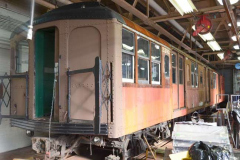
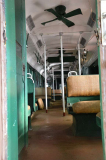
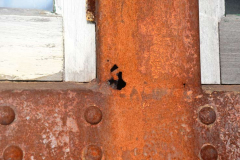
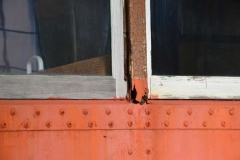
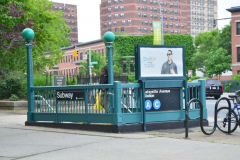
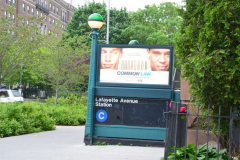
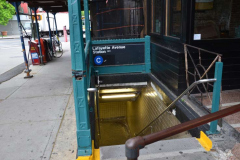
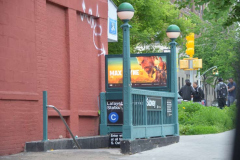
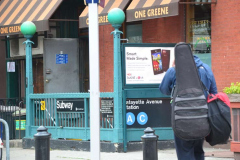
26 comments
There are a lot of closed stairways all over the System and some have been closed for over 50 Years. Some don’t lead anywhere and some do lead somewhere. Also doors that don’t lead anywhere. An old partner of mine once told me of a closed station in Brooklyn that he found by opening a door when he was a Transit Cop. According to what he was able to find out, the Station was never activated. It was on a Line that the IND never activated.
Could’ve been the South 4th Street station, which was supposed to be part of the IND’s Second System. There’s a locked doorway at the north end of the Broadway G station platform which leads to the unfinished station.
Could have been 76th St. in Ozone park.
This post confirms my belief that the New York subway system is more complex than we know. Most of these are surface representations of underground manifestations. I find it interesting that underground there are things like spurs that go nowhere and there are signs that point to destinations that never saw a train. Or things like the second Avenue subway that has been in planning and some construction since the twenties. Thats a long time to wait for a train.
A O K !
the forest parkway station on the j line used to have an entrance on, you guessed it, Forest parkway. They closed down that end of the station and even removed the stairs leading up to the token booth. Now the only entrance is on 85th street.
There’s one on Smith Street in Brooklyn outside of the Lane Bryant on Fulton Mall. I wish I could go down into it, it’s rusted to hell and I want so badly to see what is contained within… Whoever wrote this piece, I’d really REALLY like to revisit these sites with you and provide photographic assistance. I’m fascinated by the old and disused subway tunnels.
Have you checked out the Joe Korner? He has bunches of subway info. I too am interested in this stuff. I always have a camera with me when underground. I have been lucky in that i haven’t been hasseled yet.
I’m sure its just a stairway and a short walkway to the rest of the station complex. It can’t be too complex because there is an entrance to the Jay/Metrotech station on the same side of Smith Street on the other side of Fulton. Probably just a stairway and a short stretch of passageway. There could be some old ads on the walls, which would be nifty to see.
For quite a while I lived on 31st Ave almost by 56th street. I used to take the subway at an IND local station named ‘Northern Boulevard’ I never took the subway east. I always took it west to Manhattan. The only way to access that station was at the westmost end by 54th street which would put you at the first car going to Manhattan. Then one day I took it east and I noticed that there definitely was an east exit which I think would really make sense here. Does anyone remember it? It was definitely closed by 1982.
There are some subway stations that built passageways that were supposed to go to lines that would serve the IND 2nd System that never got built. It’s really a shame that the MTA never did those lines. They would served a lot of parts of the outer boroughs that are dependent much on cars. Nevertheless, it’s probably too late to build any of them except for the Second Avenue Subway, which is being built right now, but its completion is going to be pushed back, and part of that is due to the costs.
Eastbound Queens Blvd local had an entrance below the LIE overpass at the Woodhaven Blvd station. Closed long ago.
Two interesting closed entrances at the corner of Walton St. and Union Ave in Brooklyn. These were for the Flushing Ave station for the “G” train. One entrance is adjacent to an empty lot, one entrance is under a building extension.
My daughter recently moved to an apartment down the street from the Lafayette Ave station. Is it me, or has anybody else noticed that some of the stairways say A and C trains, others say just C? As far as I can tell, this is a C local stop except for late night A trains. Does that mean that only stairways marked A and C are open at night? On top of everything else, the station is at least a block away from Lafayette Ave.
The closed entrance/exit at Jay and Fulton referenced above has been re-opened – sort of. The metal doors that covered the stairs have been opened and its clear some work is going on underneath. The stairway is now visible, as is an old-fashioned “Closed” sign on a gate at the bottom of the stairs. The stairway remains barred off and inaccessible but at least its visible. Perhaps this entrance/exit is being refurbished?
Unfortunately, there is no trace at street level of the stairway on the opposite side of the street – where there is an old Schrafft’s edifice on a building.
To follow up: That entrance/exit has been demolished at street level and was resurfaced with concrete. A small hatchway remains at where the stairway was. Guess they are not refurbishing it after all.
In the nineteen-forties and early fifties, some subway stations had exits/entrances leading to department stores, office buildings, hotels, and Horn & Hardart cafeterias. New York Magazine once had an article about long underground passages of the IND in midtown Manhattan.
I’ve heard of an abandoned line or storage track between Queens Boulevard and the 1939 World’s Fair at Flushing Meadow.
IND stations were built farther apart than the IRT and BMT stations because exits were built at the ends of the stations, rather than in the center. They had gigantic mezzanines because IRT and BMT stairways were frequently overcrowded and it was estimated that by 1960, NYC would have 12 million inhabitants. The exodus to the suburbs resulting from highway expansion was not anticipated.
Many station exits were closed in the 1970s after a dramatic increase in crime and due to the budget crisis so that token booth clerks could be eliminated. With crime down and MetroCards which do not require a station agent, it no longer makes sense to keep many of these exits closed. They need to be reopened. Closing these exits on the IND was a particular hardship because it can increase your walk home by ten minutes, five minutes to reach the other end of the platform and another five to retrace your steps above ground. Some entrances have been completely obliterated such as the one at 56th Street and Northern Boulevard.
Wow. if they did not want the subway entrances, couldn’t they just destroy them and replace them with grates if they did not want these station exits? Instead of boarding them up like they are going to reopen anytime soon, they should actually have demolished the exits.
There are some abandoned entrances at the (F) Delancey Street station, long demolished.
Otherwise, those were cool photos
You should visit 205 station on the D line, as well as Fordham road.
If you visit Hoyt Schemerhorn, there is a stairway leading to the abaoned platform.Sorry for poor grammar.
Tip:Take a closer look at Norstrand Avenue (IND).Those covered signs could lead to shut down entrances.
They did, until the late 1990’s there were closed entrances at Bedford Ave and Fulton St. I started working in the area in 1981 and at the time it was already closed but senior co-workers had mentioned that the entrance had been closed only a few years earlier. While the entrance was closed, the interior underground section was used as a cross over for the northbound and southbound platforms but that was later sealed off to the public.
I’ve had thoughts about two closed-off areas near where I live. With all the gentrification that my part of Park Slope has seen, and the heavy use that the 7th Avenue Brighton Line station sees, it would be incredibly useful if they opened the unused mezzanine space that runs up Flatbush. Additionally, given how much more developed and trafficked Carroll Gardens has become, reopening Bergen Street’s lower platforms for regular F service could make a lot of things more convenient.
When I was young, I remember seeing a closed off exit at the Fort Hamilton Parkway station on the F/G. On the north end of the station, there is a long pedestrian tunnel that goes from Greenwood Ave. to Reeve Pl. Then there is a sealed off part, with a locked door, that continues tn the same direction. The existing stairway is at the southeast corner of Prospect Ave. and Reeve Pl. There was at least 2 more in the sealed off part, one on the Northeast corner of Prospect Ave. and Reeve Pl. and one on the other side of Prospect Ave. There are some steps that go down and under Prospect Ave., but could not be walked through due to it being filled with water, and rats swimming in it.
The closed off part of Bedford-Nostrand station is often used for storage and is in rather good condition. According to a relative, the Marcy and Willoughby Avenues station entrance that is now closed on the corner of Wiloughby and Marcy was a long lonely walk to the trains. A lots of crime would happen in that long passageway, even a murder and it closed around either the late 70s or early 80s. Looking at a 2013 pdf file I suspect there was another corner entrance on Vernon and Marcy that is now cover in concrete which would lead to the Marcy and Willoughby Avenues station. You can see this on google maps street view.